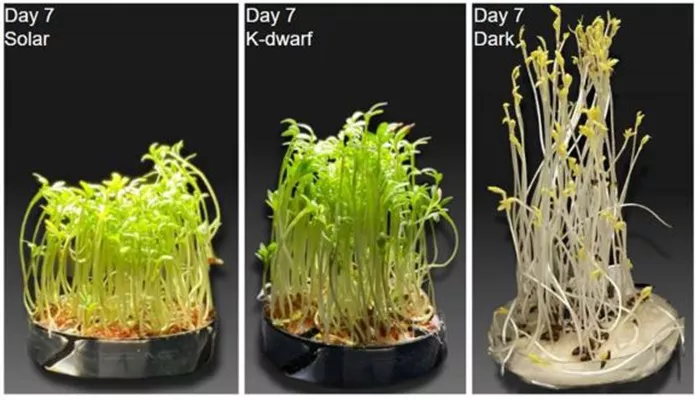Photosynthesis has played a crucial role in shaping Earth’s environment. When photosynthetic organisms emerged, they triggered the Great Oxygenation Event, which paved the way for multicellular life and the formation of the ozone layer. This layer protected life from the Sun’s harmful ultraviolet radiation, allowing life to thrive on land. But Earth’s photosynthetic organisms evolved under the light of the Sun, a G-type star. How would these organisms fare under the light of other stars?
The Sun, classified as a G-type star or yellow dwarf, is relatively uncommon in the galaxy, making up only 7% to 8% of stars in the Milky Way. As researchers search for habitable exoplanets, they must consider the more abundant star types to better understand their potential for supporting life.
K-Dwarf Stars: The Optimal Hosts?
K-dwarf stars have emerged as promising candidates for hosting habitable planets. These stars, about 50% to 80% the mass of G-type stars, are not only more abundant but also remain stable for billions of years longer. While the Sun is expected to be stable for around 10 billion years, K-dwarf stars can maintain stable luminosities for up to 70 billion years. Despite their long-term stability, much of the research into exoplanet habitability has focused on M-dwarfs, or red dwarfs, which present significant challenges for life due to frequent flaring and the likelihood of planets being tidally locked.
In a recent study, a group of researchers simulated the light from a K-dwarf star and grew two types of photosynthetic organisms under those conditions to observe how they would respond. The study, titled “Observation of Significant Photosynthesis in Garden Cress and Cyanobacteria Under Simulated Illumination from a K-Dwarf Star,” was published in the International Journal of Astrobiology. Iva Vilović, a PhD student at the Technical University of Berlin, led the research.
The Experiment: Garden Cress and Cyanobacteria Under K-Dwarf Light
The team chose two organisms for their experiment: garden cress (Lepidium sativum) and the cyanobacterium Chroococcidiopsis. Garden cress is a fast-growing plant commonly used in salads, while Chroococcidiopsis is an extremophile known for its ability to survive extreme conditions and long periods of dormancy. These two organisms were grown under three different light conditions: sunlight, simulated K-dwarf light, and complete darkness.
The study aimed to determine how photosynthesis might function on planets orbiting K-dwarf stars. Starlight provides energy for photosynthetic organisms to produce organic compounds, which is vital for life. By examining how these organisms respond to different types of light, researchers hope to gain insights into the potential for life on exoplanets around K-dwarf stars.
The Results: Faster Growth Under K-Dwarf Light
The researchers observed that both garden cress and cyanobacteria were able to photosynthesize under simulated K-dwarf light. In fact, the garden cress sprouted slightly earlier under K-dwarf light compared to sunlight. The plants also exhibited a larger leaf surface area and grew taller under the K-dwarf lighting. These results suggest that K-dwarf stars could indeed support photosynthetic life on exoplanets in their habitable zones.
The cyanobacteria also showed signs of growth under K-dwarf light, with slightly higher integrated density (IntD) values compared to those grown under sunlight. However, the differences were not considered significant. The organisms failed to thrive in complete darkness, as expected.
K-Dwarfs: The “Goldilocks Stars”
K-dwarfs offer several advantages when it comes to hosting habitable planets. Unlike M-dwarfs, K-dwarfs do not exhibit the same level of intense magnetic activity that causes frequent and powerful flares. These flares could potentially sterilize planets in the habitable zones of M-dwarfs, making life difficult or impossible. Furthermore, the habitable zones around K-dwarfs are far enough from the star to avoid tidal locking, which is another potential barrier to habitability in M-dwarf systems.
The researchers behind the study suggest that K-dwarf stars may represent the “Goldilocks stars” in the search for life-bearing planets. Their stable luminosity, lack of flaring, and non-tidally locked habitable zones make them ideal candidates for further exploration.
Limitations and Future Research
While the study provides valuable insights, the researchers acknowledge that it does not fully replicate natural conditions. On Earth, sunlight intensity varies throughout the day, with peak intensities occurring during the central hours. This variation plays a critical role in how plants adapt to changing light conditions. The experiment used constant light intensity, which does not account for the effects of non-photochemical quenching (NPQ), a process that helps plants cope with excess light by dissipating it as heat.
The researchers emphasize the importance of understanding how K-dwarf radiation affects photosynthesis and growth, not only for evaluating the potential habitability of exoplanets but also for interpreting atmospheric biosignatures beyond our Solar System.
A Step Forward in Astrobiology
This study marks an important step in understanding how photosynthesis might function under different types of starlight. While previous research has focused on M-dwarfs, this is one of the first studies to examine photosynthesis under K-dwarf light. As astronomers continue to search for habitable planets, K-dwarfs could play a key role in identifying potential life-bearing worlds.


